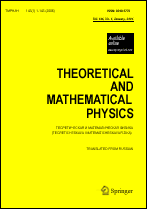|
Pauli graphs, Riemann hypothesis, and Goldbach pairs
M. Planata, F. Anselmia, P. Soléb
a FEMTO-ST Institute, CNRS, Besançon, France
b Telecom ParisTech, Paris, France
Abstract:
We consider the Pauli group $\mathcal{P}_q$ generated by unitary quantum generators
$X$ (shift) and $Z$ (clock) acting on vectors of the $q$-dimensional Hilbert space. It has been found that the number of maximal
mutually commuting sets within $\mathcal{P}_q$ is controlled by the Dedekind psi
function $\psi(q)$ and that there exists a specific inequality involving the Euler constant $\gamma\sim0.577$ that is only satisfied at specific low
dimensions $q\in\mathcal{A}=\{2,3,4,5,6,8,10,12,18,30\}$. The set $\mathcal{A}$ is closely
related to the set $\mathcal{A}\cup\{1,24\}$ of integers that are totally Goldbach,
i.e., that consist of all primes $p<n-1$ with $p$ not dividing $n$ and such
that $n-p$ is prime. In the extreme high-dimensional case, at primorial
numbers $N_r$, the Hardy–Littlewood function $R(q)$ is introduced for
estimating the number of Goldbach pairs, and a new inequality
(Theorem $4$) is established for the equivalence to the Riemann
hypothesis in terms of $R(N_r)$. We discuss these number-theoretical
properties in the context of the qudit commutation structure.
Keywords:
Riemann hypothesis, Goldbach pair, generalized Pauli group, qudit commutation structure.
Received: 14.04.2011
Citation:
M. Planat, F. Anselmi, P. Solé, “Pauli graphs, Riemann hypothesis, and Goldbach pairs”, TMF, 171:3 (2012), 417–429; Theoret. and Math. Phys., 171:3 (2012), 780–791
Linking options:
https://www.mathnet.ru/eng/tmf6894https://doi.org/10.4213/tmf6894 https://www.mathnet.ru/eng/tmf/v171/i3/p417
|


| Statistics & downloads: |
| Abstract page: | 440 | | Full-text PDF : | 195 | | References: | 90 | | First page: | 15 |
|




 Contact us:
Contact us: Terms of Use
Terms of Use
 Registration to the website
Registration to the website Logotypes
Logotypes








 Citation in format
Citation in format 